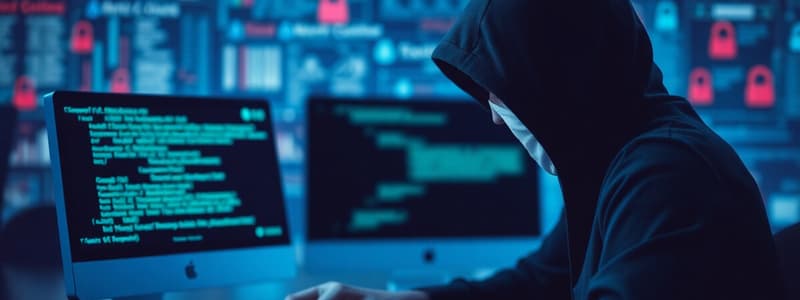Podcast
Questions and Answers
What type of malware replicates itself over a network?
What type of malware replicates itself over a network?
- Virus
- Trojan
- Worm (correct)
- Spyware
What is a characteristic of a Trojan?
What is a characteristic of a Trojan?
- Infects your computer and takes control of its functions
- Replicates itself without user intervention
- Monitors user movements and collects data
- Facilitates unauthorized access to your workstation (correct)
Which of the following statements best describes social engineering?
Which of the following statements best describes social engineering?
- An intricate phishing strategy involving complex software
- A method to patch human errors in systems
- An attack that relies on human interactions to gain confidential information (correct)
- An attack that targets software vulnerabilities
What is the main reason social engineering is considered effective?
What is the main reason social engineering is considered effective?
What does spyware primarily do?
What does spyware primarily do?
Which type of malware is described as malicious software that can take control of a computer's functions?
Which type of malware is described as malicious software that can take control of a computer's functions?
Why is human error considered a significant vulnerability in information security?
Why is human error considered a significant vulnerability in information security?
What is a common misconception about malware types?
What is a common misconception about malware types?
What makes social engineering attacks particularly difficult to track?
What makes social engineering attacks particularly difficult to track?
What is a crucial action to take when you step away from your workstation?
What is a crucial action to take when you step away from your workstation?
Why is it essential to keep your operating system and applications updated?
Why is it essential to keep your operating system and applications updated?
What should you be cautious about when installing applications on your device?
What should you be cautious about when installing applications on your device?
What is the best practice regarding passwords for various accounts?
What is the best practice regarding passwords for various accounts?
What should you avoid doing with smartphones and your PC?
What should you avoid doing with smartphones and your PC?
Which of the following statements about data backup is true?
Which of the following statements about data backup is true?
What is a primary focus of incident reporting in information security?
What is a primary focus of incident reporting in information security?
Which of the following is NOT a characteristic of phishing emails?
Which of the following is NOT a characteristic of phishing emails?
Which scenario represents a positive outcome in incident reporting?
Which scenario represents a positive outcome in incident reporting?
What can be considered a significant risk in the context of digital information?
What can be considered a significant risk in the context of digital information?
What is an Advanced Persistent Threat (APT)?
What is an Advanced Persistent Threat (APT)?
What might be a potential consequence of a successful phishing attack as represented in the case?
What might be a potential consequence of a successful phishing attack as represented in the case?
Which of the following actions can help prevent APTs?
Which of the following actions can help prevent APTs?
What is a crucial part of the incident reporting process as outlined?
What is a crucial part of the incident reporting process as outlined?
What method is utilized in human-based attacks for gaining unauthorized access?
What method is utilized in human-based attacks for gaining unauthorized access?
Which action is critical within the incident reporting framework after an issue is fixed?
Which action is critical within the incident reporting framework after an issue is fixed?
Which of the following represents a social engineering attack?
Which of the following represents a social engineering attack?
What is a common technique used in information gathering attacks?
What is a common technique used in information gathering attacks?
How does the awareness session relate to handling online scams effectively?
How does the awareness session relate to handling online scams effectively?
What characterizes a phishing attack, based on the examples provided?
What characterizes a phishing attack, based on the examples provided?
Which of the following terms describes attacks that exploit user trust?
Which of the following terms describes attacks that exploit user trust?
In which way can staff play a role in preventing the consequences of phishing attacks?
In which way can staff play a role in preventing the consequences of phishing attacks?
Shoulder surfing primarily aims to achieve what?
Shoulder surfing primarily aims to achieve what?
What is one of the primary roles of staff in information security?
What is one of the primary roles of staff in information security?
What indicates a failed response to a phishing attempt in the scenario provided?
What indicates a failed response to a phishing attempt in the scenario provided?
Which activities are part of dumpster diving as a social engineering attack?
Which activities are part of dumpster diving as a social engineering attack?
What is a fundamental guideline for selecting a strong password?
What is a fundamental guideline for selecting a strong password?
Which statement best describes the Web of Trust (WOT)?
Which statement best describes the Web of Trust (WOT)?
What is one recommended practice for email security?
What is one recommended practice for email security?
Which of the following is a best practice regarding social networking security?
Which of the following is a best practice regarding social networking security?
What should be done with documents containing sensitive information?
What should be done with documents containing sensitive information?
What precaution should be taken when using mobile phones for work?
What precaution should be taken when using mobile phones for work?
Which of the following is NOT considered a physical security measure?
Which of the following is NOT considered a physical security measure?
What should be the primary action when encountering a suspicious email?
What should be the primary action when encountering a suspicious email?
What is an important consideration regarding third-party applications on social networks?
What is an important consideration regarding third-party applications on social networks?
Which of the following is essential for mobile security?
Which of the following is essential for mobile security?
Flashcards are hidden until you start studying
Study Notes
Malware
- Malware is a malicious software designed to harm computer systems and steal information.
- Types of malware include: Spyware, Trojans, Viruses, and Worms.
- Spyware tracks your online activity and sends it to malicious entities, like phishing websites that steal your login information.
- Trojan viruses are hidden within legitimate programs that appear harmless. Trojans can give adversaries access to your workstation and steal data.
- A virus can infect your computer and take control of its functions.
- Worms are viruses that can replicate and spread across a network without human interaction.
Social Engineering
- Social engineering is the art of human hacking where adversaries exploit human error to gain access to networks and information.
- Social engineering is effective because every user has information, which adversaries try to steal.
- Social Engineering attacks are difficult to detect and track.
Types of Social Engineering Attacks
- Social-media vectors, shoulder surfing, dumpster diving, impersonation, phishing, and online scams are all attacks that involve humans.
- Phishing emails attempt to deceive recipients into clicking malicious links.
- Phishing email characteristics include deceptive subject lines, attractive or threatening messages, forged sender addresses, and forged content.
- Advanced Persistent Threats are long-term attacks where adversaries use social engineering to gain access to a network and steal data.
Information Gathering
- Staff are the first line of defense against information breaches.
Incident Reporting
- Report, fix, and follow-up are the key steps to minimize risks.
- Staff should report all incidents to the Incident reporting coordinator and Business line manager.
- The Repair and support unit will fix the issue and the Incident reporting coordinator will follow-up.
Security Tips and Countermeasures
- Use HTTPS links to safeguard information while browsing online.
- Use the Web of Trust (WOT) tool to identify trustworthy websites and ensure safe online shopping and banking.
- Use strong passwords, don't share them with anyone, and change them frequently.
- Implement physical security protocols, such as clear desk and screen policies and locking up portable devices.
- Always back up your sensitive data.
- Never open email attachments from unknown senders.
- Be aware of mobile threats and download apps only from trusted sources.
- Use screen locks on mobile devices.
- Never plug your phone into a PC.
- Keep your phone operating system and apps updated.
Security: Behavior vs Technology
- Security is 80% about behavior and 20% about technology.
Studying That Suits You
Use AI to generate personalized quizzes and flashcards to suit your learning preferences.




